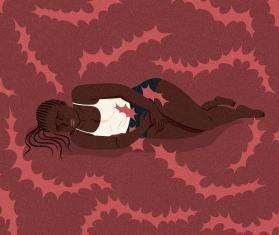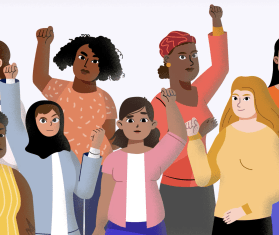Key points
- Unsafe abortion is a significant contributor to maternal mortality worldwide.
- Over 29,000 women and girls die annually due to unsafe abortion.
- People resort to unsafe abortion due to a lack of safe options and unbearable pregnancies.
- Legal limitations, moral judgment, and stigma can inhibit access to safe abortion care.
Unsafe abortion remains one of the five leading causes of maternal mortality, despite the fact that it is mostly preventable. In recent decades, the world has made significant progress in reducing many causes of maternal deaths—severe bleeding, severe infection, blood pressure disorders, and obstructed labor—yet there has been little improvement to diminish the dangers of unsafe abortion.
Unsafe abortion is a procedure for terminating an unwanted pregnancy either by people lacking the necessary skills, or in an environment lacking minimal medical standards, or both, as defined by the World Health Organization.
Abortion, whether safe or unsafe, is a common event worldwide: one in six unintended pregnancies ends in abortion, and one in three of all pregnancies, including planned pregnancies, ends in an abortion. Forty-five percent of all abortions globally are deemed unsafe.
women and girls are injured or disabled due to unsafe abortions every year.
of all unsafe abortions occur in developing countries.
women and girls die as a result of unsafe abortions every year.
Unsafe abortion rates around the world
More than 29,000 people die each year due to unsafe abortion, the majority in developing countries across Africa, Asia, and Latin America—all regions where Doctors Without Borders/Médecins Sans Frontières (MSF) provides medical aid, including safe abortion care. Our teams treat women and girls harmed by complications from unsafe abortions every single day.
When a woman or girl is determined to end her pregnancy she will do so, regardless of the safety and legality of the procedure. Where safe abortion care is not available, she will often risk her life with an unsafe abortion because the prospect of continuing the pregnancy is unbearable.
Meanwhile, the scale of post-abortion complications is enormous, with an estimated seven million women and girls hospitalized every year. Some will be permanently disabled, and some will never be able to carry a child again. Yet we will never know the full extent of the problem, because there are many women and girls who cannot get access to medical care.

DR Congo 2019 © Davide Scalenghe/MSF
Unsafe abortion is a medical crisis
In 2022, MSF staff treated over 25,000 women and girls for abortion-related concerns and complications, many of which resulted from unsafe attempts to terminate pregnancy.
The woman or girl may have consulted an unskilled provider, or attempted the abortion herself. The history of unsafe abortion is marked by dangerous abortion methods—including the use of sharp sticks inserted through the vagina and cervix into the uterus; ingestion of toxic substances such as bleach; herbal preparations inserted into the vagina; infliction of trauma, such as hitting the abdomen or falling. Many of these unsafe abortion methods are not even effective in terminating the pregnancy, but can leave lasting damage.
For women who use these unsafe methods, the life-threatening consequences include severe hemorrhage, sepsis (severe general infection), poisoning, uterine perforation, or damage to other internal organs. A woman may require urgent hospital care for a blood transfusion, major reparative surgery, or a hysterectomy—the complete, and irreversible, removal of the uterus.
Some women are able to access somewhat safer methods like medication on the black market, but they may still suffer complications due to poor drug quality, incorrect dosing, inadequate information, or a combination of these factors.
In the worst-case scenario, the woman being treated may have been refused a safe abortion, only to reappear with life-threatening injuries due to an unsafe one. In the Democratic Republic of Congo (DRC), where abortion used to be extremely restricted legally, emergency department doctor Jean-Paul remains shaken by his direct experience of encountering a girl seeking an abortion. Denied care in the MSF hospital he was working in, she returned in a coma, and died not long afterward.

Five takeaways from MSF’s study on unsafe abortions
Read moreHow moral judgment and shame impact dangerous abortions
A woman may hope to be pregnant one day in the future, but not necessarily right now. MSF’s experience in countries such as Colombia, Greece, Mozambique, and South Africa, to name just a few, has confirmed the diversity of woman and girls facing an unwanted pregnancy: our patients are married and unmarried, women with children as well as girls attending school, women from urban centers and rural villages alike.
Some of these women and girls used contraception that failed or ran out due to interrupted supply. Some became pregnant due to sexual violence or coercion. Others faced financial and emotional hardship, with and without partners or family support. Some were caught up in a humanitarian crisis or forced from their homes, struggling just to survive.

MSF
There can be as much shame and stigma surrounding the reasons behind an unwanted pregnancy as the concept of abortion itself. This means that many women and girls are left to face difficult questions alone. Where can I go for help? What are my options? What will it cost? Will it be painful? What if I can never have children again? What will this mean for me and my family if people find out?
Most women have already thought about their options and made the decision before seeking care. Some women may ask for more information before deciding whether to have an abortion. Our role as medical providers is to listen and provide the appropriate level of support and information, respecting her decision without judging or influencing her.
Consultation with a trained professional also ensures that the woman understands the risks and benefits of an abortion, knows what she will experience during the process, and has the opportunity to ask questions.
Legal limitations to abortion
The fact that abortion is still criminalized in most countries remains a concern. The evidence is clear that the number of abortions changes little when there are legal restrictions. Instead, where abortion is most restricted, it is more likely to be unsafe. Where abortion is legal and safe services are available, deaths and disability from abortion are greatly reduced.
Prompted by the evidence, some countries have reformed their laws.
Legislation in DRC changed in April 2018. Since then, all medical facilities have the obligation to provide termination of pregnancy for women who have been victims of rape or sexual abuse, or whose physical or mental health is at risk.
Mozambique revised its stance four years earlier, in 2014, allowing for cost-free abortion for all women in the first trimester, and up to 24 weeks under special circumstances in approved facilities by qualified practitioners.
Barriers in the health care system can lead to unsafe abortion
Liberalization and decriminalization of abortion are important steps, but they do not guarantee the availability of safe abortion care. Many health systems respond slowly, and inconsistently, to change.
In Mozambique, for example, clinical standards for safe abortion were only defined in 2017. Institutional opposition, resistance from health workers, and knowledge gaps on the part of decision-makers have all hindered the wider implementation of safe abortion care in the country, and many women still do not know how to access services.
In Colombia, significant decriminalization of abortion was achieved 12 years ago. But in the port cities of Buenaventura and Tumaco, MSF found general ignorance about the current scope of safe abortion care. Health care workers who should have been prepared to undertake this type of care were not even aware that it was part of their duty.
For a woman or girl with an unwanted pregnancy, it can be hard to overcome the sometimes strong resistance from health care providers, which may even extend to the denial of care.
In Athens, where MSF supports migrants, asylum-seekers, and refugees to access safe abortion care in the public health system, women join a waiting list more than four weeks long just to have their first appointment. More appointments with more health professionals, especially doctors, follow. Some patients face additional obstacles, because they don’t have their social security identification with them, or attend an appointment without a translator.
In Greece, the legal limit for abortion is 12 weeks, so women must race against the clock to navigate the many hurdles in order to end their pregnancy within that period.
To prevent unsafe abortions, simplify abortion access
Termination of pregnancy is a safe and effective medical act, usually managed with tablets (medication abortion) or a minor intervention under local anesthesia (manual vacuum aspiration, or MVA). Both of these abortion methods are less risky than an injection of penicillin.
Medication abortion involves two drugs, mifepristone and misoprostol, and a total of only five pills. It is often the preferred method for women, as it is less invasive and can be started as an outpatient and completed in the privacy of one’s own home.
Doctors are not necessary to provide these services; midwives and nurses can provide both of these abortion methods in hospitals and health centers alike, as long as they have the skills.
Even so, in places where health services are stretched, providers can benefit greatly from additional support—further training, institutional backing, mentoring, and guidance. In Rustenburg, South Africa, this is an important component of nurse Kgaladi Mphahlele’s work as a Choice of Termination of Pregnancy Manager on behalf of MSF. The district health service is committed to providing safe abortion care, but staff can be unsure of correct methods and protocol.
Some staff also need moral support in the face of judgment and stigma from colleagues in the workplace. Even knowing the importance of safe abortion care, many health providers—including MSF—must confront their personal attitudes toward providing this care. Peer support is important.
Ensuring abortion safety
Safe abortion care is a package of essential health services: management of post-abortion complications, safe termination of pregnancy, and provision of contraceptives. These services need to be timely, reliable, confidential, skilled, and compassionate. They must be provided by people who have been properly trained.
Contraception and safe abortion care go hand in hand in the strategy to reduce unwanted pregnancies, unsafe abortions, and maternal deaths. Increasing access to modern contraception is an essential component to reducing unintended or unwanted pregnancies, and the abortions or unplanned births that often follow. However, contraception alone is not sufficient as a solution.
Safe abortion care at MSF
MSF is working with its staff, with local communities, health departments and ministries, and other non-governmental health care providers to improve access to contraceptives, to post-abortion care and to the safe termination of pregnancy for women and girls lacking access to health care or caught in a humanitarian crisis.
Unwanted pregnancy and unsafe abortion have serious medical impacts on women and girls in many of the low-resource settings and conflict-affected countries where MSF works. The consequences of unsafe abortion are also felt by these women’s families and friends, caregivers—including MSF staff—and their wider community. As a medical and humanitarian organization, MSF remains committed to providing safe abortion care to reduce this avoidable—and often overlooked—cause of suffering.
A woman deserves health care that responds to her medical needs, including access to safe abortion care




